Lessons Learned in Inclusive Transit Planning with Persons with Disabilities, Older Adults, and Priority Populations
- Date: 04/11/2024
The Community Transportation Association of America (CTAA) and the Transit Planning 4 All (TP4A) partners undertook this research effort to…

